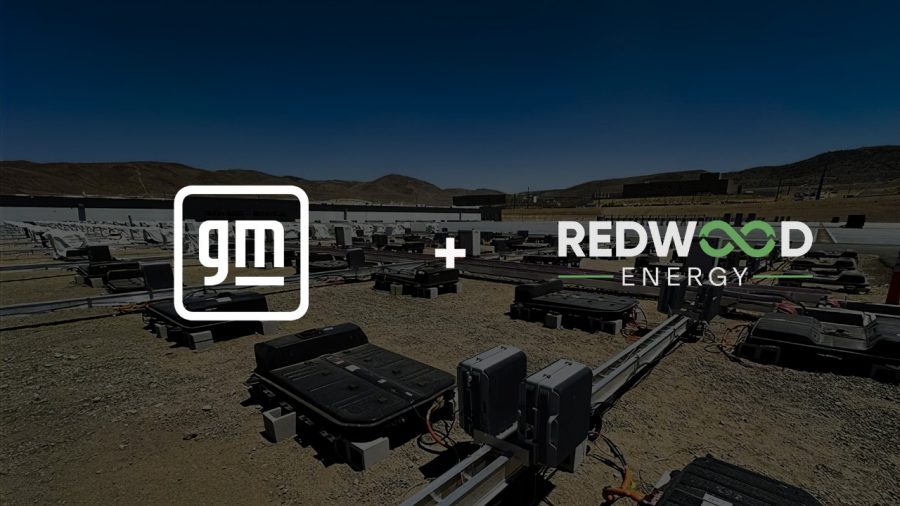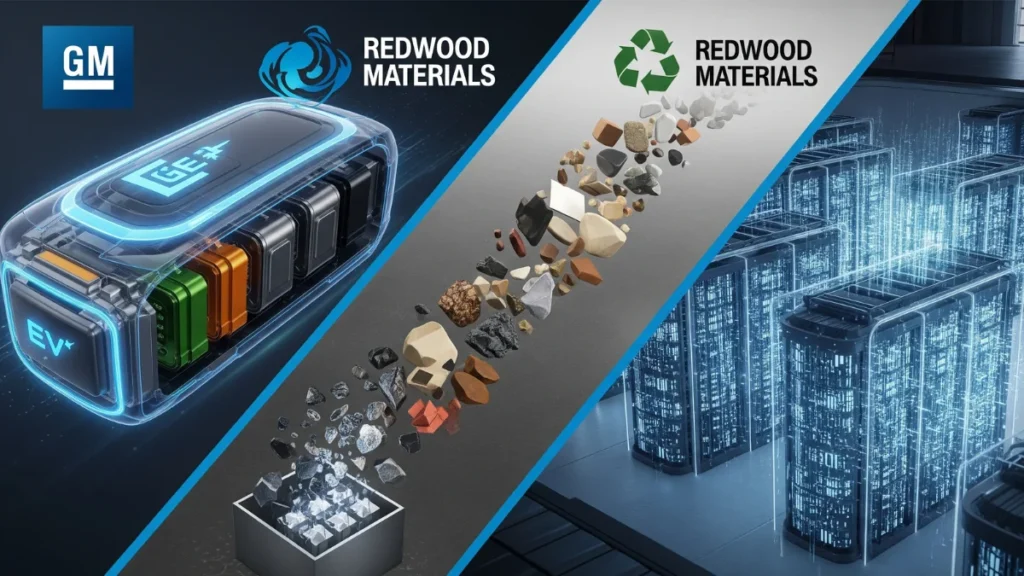AI’s insane energy demand is straining America’s power grid. But in a Nevada desert, something big is quietly happening—used EV batteries are being reborn as the backbone of a clean energy solution for AI. And GM is leading the charge.
Key Takeaways:
- GM partners with Redwood Materials to repurpose EV batteries into energy storage systems.
- These batteries now help power Crusoe’s AI data centers with clean, renewable energy.
- The effort could reduce reliance on gas-powered plants and cut emissions significantly.
- Used EV batteries retain up to 80% capacity—perfect for grid storage, even if not for vehicles.
- 🇺🇸 This scalable solution could strengthen U.S. grid independence and support the AI revolution.
Just outside Reno, where the desert sun scorches vast stretches of land, rows of solar panels quietly soak up the rays. Nearby, under sheets of white plastic, sit used EV batteries, retired from American roads—but far from dead.
These recycled batteries are now playing a surprising new role: powering AI.
Crusoe, a growing artificial intelligence cloud platform, has two data centers in the area. They’re running 24/7 thanks to a mix of solar energy and backup battery power—provided not by new tech, but by second-life EV batteries, once used in GM vehicles.
“The whole AI industry is struggling to access reliable power fast enough,” said Cully Cavness, Crusoe’s co-founder and COO. “Gas power is quick, but it’s dirty. Recycled EV batteries are fast and clean.”
And clean is key—because AI is hungry.
A 2024 U.S. Department of Energy report found that data centres could consume up to 12% of all U.S. electricity by 2028—a threefold increase from today’s levels. Texas alone has proposals for over 100 new gas-fired power plants, many aimed at feeding AI’s rising demand.
But Crusoe, GM, and Redwood Materials believe there’s a better way.
Turning Scrap Into Grid Gold
Redwood Materials, the Nevada-based recycling company founded by former Tesla CTO JB Straubel, is at the centre of this energy shift. The company recovers lithium-ion batteries from vehicles and repurposes them into energy storage systems.
In 2024 alone, Redwood recovered over 20 gigawatt hours of battery materials—enough to power 250,000 new electric vehicles.
GM recently formalized a partnership with Redwood to deepen their collaboration. Together, they’re taking used batteries and turning them into large-scale battery backup systems—also known as microgrids—that provide steady, renewable energy to AI servers.
Redwood CTO Colin Campbell sees it as simple economics. “These batteries may have lost 20% of their capacity—but they’re still powerful. They may not be ideal for cars anymore, but they’re perfect for the grid.”
The best part? The system is designed to be plug-and-play. No complex pumps or piping—just modular storage units that can be deployed quickly and cheaply.

A Scalable, Sustainable Solution
The batteries already in use at Crusoe’s Nevada microgrid are impressive:
- 12 megawatts of instantaneous power
- 63 megawatt hours of total energy storage capacity
According to GM’s battery chief Kurt Kelty, “The market for backup power is no longer niche—it’s essential. And EV batteries are ready to meet that need.”
GM’s strategy goes beyond just sustainability. It’s also about U.S. energy independence. These battery systems can be made and deployed locally, sidestepping global supply chain dependencies.
And the batteries aren’t just from end-of-life cars. GM is also recycling production scrap from its Ultium battery plants in Ohio and Tennessee, part of its joint venture with LG Energy Solution.
The Second Life of a Battery
What makes a battery “dead” for a car isn’t a complete loss of functionality. According to Liz Najman of EV research firm Recurrent, many batteries still retain 70-80% of their original charge capacity.
“That’s not enough for a driver chasing full range—but for grid storage, it’s perfect,” she explained. “These batteries can last another 10 to 20 years once pulled from a vehicle.”
Modern microgrids—like the one in Nevada—benefit hugely from these repurposed batteries. They’re resilient, off-grid, and not subject to traditional utility regulations.
Najman adds: “We don’t fully know how long these will last. But it’s longer than most people expect.”
What This Means for the AI Energy Race
As AI continues to drive up energy demand, the U.S. needs fast, clean, and scalable energy solutions. Recycled EV batteries offer an elegant answer.
JB Straubel calls it “a different way to power the AI revolution,” one that doesn’t rely on fossil fuels or strain the existing electric grid.
Redwood’s modular battery systems can be replicated quickly across the country—wherever AI infrastructure pops up next. And with GM in the mix, the scale is potentially massive.
While Europe and China are leading the global EV battery recycling market, the U.S. is catching up fast. By 2030, experts expect global recycling capacity to triple, with the U.S. representing a growing slice of the pie.
Conclusion
Recycled EV batteries won’t just sit in scrapyards or rot in landfills. They’re being transformed into one of America’s most critical tools for powering the AI era—cleanly, efficiently, and at scale.
With major players like GM and Redwood Materials pushing forward, the AI industry may soon find itself running on yesterday’s car batteries—and that’s a very smart future.
Source Link: GM and Redwood Materials to pursue use of U.S.
